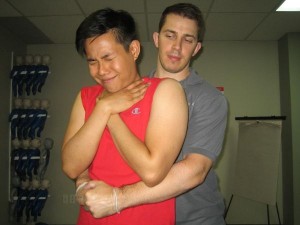Choking is a serious concern, often for parents, and is one of the reasons many people 
Choking can be identified by firstly asking if the patient is choking. This sounds obvious but can determine if they have any difficulty in speaking, coughing and/or breathing. If these tasks are difficult then they have a moderate obstruction. If, however, they are unable to speak, cough or breathe this is a severe obstruction.
A severe obstruction will eventually lead to loss of consciousness.
workplace approved Training teaches first aiders that if the patient loses consciousness, open their airway, check their breathing. Be ready to start chest compressions and rescue breaths if needed. It is not advised to do a finger sweep of the mouth.
The treatment of a choking adult, is to give five back blows then five abdominal thrusts, checking their mouth in between each to see if the obstruction has cleared. If after three sequences there is no improvement, an ambulance must be called.
Try to encourage the patient to cough to try to remove any obstruction in their airway. If this is not successful, proceed to back blows as per First Aid Classes.
How to give Back Blows
Bend the patient forwards and give five sharp blows with the heel of your hand, between the patients shoulder blades. This must be quite hard as you are trying to dislodge the obstruction.
Check the patients mouth to see if the obstruction has been cleared. If choking continues then move onto abdominal thrusts.
How to give Abdominal Thrusts (this used to be called the Heimlich manouvre)
Stand behind the patient and put both of your arms around them. Make a fist with one hand and place it between the patients naval and the bottom of their breastbone. Cover your fist with your other hand and pull inwards and upwards sharply. Repeat this five times, then recheck the mouth for the obstructing object.
As mentioned earlier, if there is no improvement after three sequences, an ambulance must be called. Then continue this pattern until help arrives or until the obstruction is cleared. If the patient loses consciousness before help arrives, check their airway, breathing and pulse and be prepared to give CPR if it is needed.
REFERENCES
First Aid Manual (The Authorised Manual of St. John Ambulance, St Andrew’s Ambulance Association and the British workplace approved), 2006.
